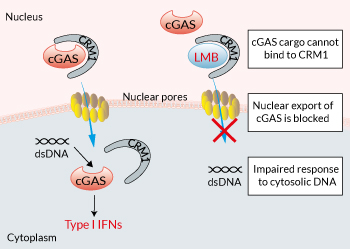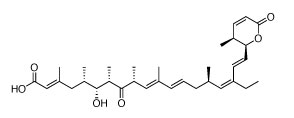Leptomycin B
| Product | Unit size | Cat. code | Docs. | Qty. | Price | |
|---|---|---|---|---|---|---|
|
Leptomycin B Nuclear export inhibitor |
Show product |
10 x 5 µg |
inh-lep-10
|
|
Inhibitor of cGAS nuclear export

Inhibition of nuclear export by Leptomycin B (LMB)
Leptomycin B (LMB), an antifungal antibiotic from Streptomyces species, is a specific inhibitor of nuclear export [1-3]. Its cellular target is chromosomal region maintenance 1 protein (CRM1), also known as exportin 1 or Xpo1 [3]. Notably, CRM1 is the major receptor for the nuclear export of proteins and RNA containing a nuclear export signal (NES) [1, 2]. Hence, LMB is a valuable tool for studying nucleocytoplasmic transport.
Mode of action:
Specifically, LMB blocks nuclear export by binding to CRM1 at Cys528 residing in its NES-binding groove and inhibits the binding of the cargo to CRM1 [4]. By inhibiting nuclear export LMB can cause the nuclear accumulation of proteins that shuttle between the cytosol and nucleus such as the DNA sensor cGAS [1], the serine kinase IRAK-1 [2], and the NOD‑like receptor (NLR) family member NLRC5 [3].
Of note, by inducing the nuclear accumulation of cGAS, LMB impairs the production of interferons (IFNs) in response to DNA stimulation [1]. LMB has also been reported to inhibit the degradation and subsequently lead to the accumulation of p53 within the nucleus [4]. Moreover, research has demonstrated that LMB displays anti-tumor properties by inhibiting the proliferation, migration, and invasion of carcinoma cells [5].
Key features:
- A potent inhibitor of nuclear export
- Supplied as a ready-to-use solution
![]() Read our review on cGAS.
Read our review on cGAS.
References:
1. Sun H. et al., 2021. A nuclear export signal is required for cGAS to sense cytosolic DNA. Cell Rep. 34(1):108586.
2. Liu G. et al., 2008. Interleukin-1 receptor-associated kinase (IRAK)-1-mediated NF-kB activation requires cytosolic and nuclear activity. FASEB J 22(7): 2285-96.
3. Benko S. et al., 2010. NLRC5 limits the activation of inflammatory pathways. J Immunol. 185(3):1681-91.
4. Kudo N. et al., 1999. Leptomycin B inactivates CRM1/exportin 1 by covalent modification at a cysteine residue in the central conserved region. PNAS. 96(16):9112-7.
5. Zhu H. et al., 2020. Leptomycin B inhibits the proliferation, migration, and invasion of cultured gastric carcinoma cells. Biosci Biotechnol Biochem. 84(2):290-296.
Specifications
CAS number: 87081-35-4
Appearance: Clear, colorless solution
Working concentration: 50-100 nM
Formula: C33H48O6
Molecular weight: 540.73 g/mol
Quality control:
- The absence of bacterial contamination (e.g. lipoproteins and endotoxins) is confirmed using HEK-Blue™ TLR2 and HEK-Blue™ TLR4 cells.
Contents
- 10 x 5 µg Leptomycin B is provided as 930 µL of a 10 µM solution (5.4 µg/ml in ethanol)
Note: This product is packaged under argon gas.
![]() Leptomycin B is shipped at room temperature
Leptomycin B is shipped at room temperature
![]() Upon receipt, store at -20˚C.
Upon receipt, store at -20˚C.
STABILITY WARNING: Leptomycin B in any quantity is unstable when dried down into a film. Thus, under no circumstances should the solvent be removed from solutions of Leptomycin B, because rapid decomposition and loss of recoverable material will result.
Back to the topDetails
Nuclear transport
The transport of proteins, RNA, and ribonucleoprotein complexes across the nuclear membrane is essential for normal cellular functions, such as transcription, cell signaling, and cell cycle regulation [1, 2]. Unsurprisingly, the trafficking of these molecules is a highly regulated process; with the entry and exit from the nucleus tightly controlled by the nuclear pore complexes (NPCs). Although small molecules can enter the nucleus without regulation, large molecules such as proteins, RNA, and ribonucleoprotein complexes require association with transport factors known as nuclear transport receptors, such as karyopherins called importins to enter the nucleus and exportins to exit [2].
In eukaryotes, chromosomal region maintenance 1 (CRM1), also known as exportin 1 or Xpo1, is the major karyopherin receptor that mediates the nuclear export of various proteins, nuclear export signal (NES)-containing RNA, and ribonucleoprotein complexes [2]. The import of proteins into the nucleus occurs by several different receptors, including importin β and transportin-1. Of note, dysregulation of nuclear export and import results in the mislocalization of specific cargo proteins and is associated with the pathogenesis of disease states such as cancer, inflammation, viral illness, and neurodegenerative diseases [1, 2].
1. Nachmias B. & Schimmer AD., 20120. Targeting nuclear import and export in hematological malignancies. Leukemia. 34(11):2875-2886.
2. Kosyna F.K. & Depping R., 2018. Controlling the Gatekeeper: Therapeutic Targeting of Nuclear Transport. Cells. 7(11):221.
Chemical structure of Leptomycin B:





